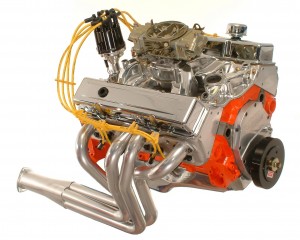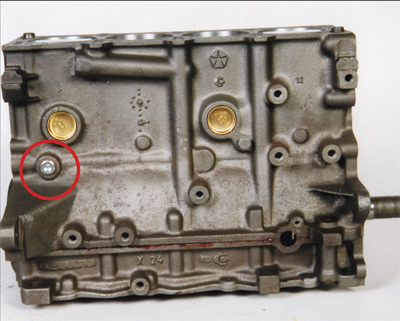What You Need To Know About SBC Port Volumes
A 4-cycle engine is far from being a simple air pump. The principle reason turning apparent simplicity into real world complexity is the dynamic ‘stop – start’ nature of the flow through the engine and the fact that air is very much heavier than is often supposed. Rapidly changing rates of pressure and suction bring

Valve Failure Analysis: Impact and Fatigue
Since the least common result of valve failure is the valve itself, it is always necessary to determine the cause of failure prior to replacement of the damaged valves (Figure 1). Impact Failure The illustration in Figure 2 shows the characteristic appearance of an impact failure. NOTE: Breakage by impact is a sudden failure. Example:
Chrysler 2.4L Cylinder Block Casting Identification
Chrysler replaced its old SOHC four cylinders with an all-new family of SOHC and DOHC engines in 1995. There were 2.0L SOHC and DOHC versions, along with a 2.4L DOHC that was installed in the FWD cars and minivans. Over the years, this engine has been used in several other applications including the PT Cruiser,

Oil Seepage From Back of Cylinder Head on Mercedes M272/273 Engines
If you receive customer reports of oil seeping from Mercedes vehicles equipped with M272/273 engines, the cause could be the round plastic expansion plugs on the back of the cylinder heads (Figure 1). To resolve, perform the following. Note: As of June 2008 production, new improved plugs were phased into production. There are two
Use Simple 10-second Check to Avoid Three Common Valve-Lock Problems
By Fergus Ogilvy Assemble the valve locks on a valve and using your thumb and forefinger raise the retainer to its full height. If the assembly defies gravity and remains in place and doesn’t rock, the quality of the valve locking assembly is superior. If, however, the assembly falls apart, the valve-locking mechanism is deficient
Multiple Cylinder Misfire or Rough Idle on 2004-’06 Chrysler 3.5L Engines
This bulletin involves rotating all engine exhaust valves, replacingthe valve spring retainer locks with a new design to increase valverotation at lower rpm, inspecting/replacing the MAP sensor (asnecessary), and decarbonizing the combustion chamber. Symptom/Condition The customer may experience occasional engine misfire (rough-running engine) during certain vehicle operating conditions. In addition, MIL illumination may also have
Tips For Selecting a Carbureted Intake Manifold
Performance intake manifold manufacturers offer several different options to get air and fuel from carb to heads. The secret is choosing the right intake manifold for your specific application using these three easy steps: Dual-Plane, Single-Plane or Others Carbureted intake manifolds come in a variety of styles: dual-plane, single-plane, air-gap, tunnel ram and others. Choosing
Oil Leak Repair for 1990-1993 4.0L Ford V6 Engines
The most common oil leak on ’90-’93 4.0L engines is often diagnosed as a rear seal leak, but in most cases, the problem is usually found to be the rear of the oil pan gasket. Since 1990, when the 4.0L was first introduced, Ford redesigned the gasket twice and even the oil pan casting to
Motor Oil Fact or Fiction
1. Synthetic motor oil is too slippery. It causes roller bearings to slide instead of roll, and that causes the bearings to fail. Fact or Fiction? – Fiction If you have ever flown on a jet airplane, you have enough experience to debunk this myth. All jet turbine engines utilize rolling-element bearings, and every jet
Engine Whine Sounds at Idle Reported on Some Chrysler 6.1L Engines
This bulletin applies to Chyrsler models equipped with a 6.1L engine with an engine serial number of TNXE6026620001 or less. Theengine serial number can be found on a label located on the upper sideof the left or right engine front cover. SYMPTOM/CONDITION: Some customers may notice a whine sound at idle after the vehicle hasbeen
Chrysler 3.7L Throttle Body ‘Whistle-Like Sounds’
This repair procedure involves applying a thin bead of RTV to theintake manifold-to-throttle body joint.This information applies tovehicles equipped with a 3.7L engine built on or before March 12, 2007. There have been reports of vehicle owners who experience a slight“high frequency (pitch)” whistle-like sound while driving. This soundis not loud and may not be
Destroking or Decompressing Pistons
The clearance inside the combustion chamber is reduced when the engine block surface or cylinder head surface has been resurfaced. The reduced combustion chamber clearance may allow the valves to come in contact with the head of the piston, resulting in an engine failure. The using of destroked pistons eliminates this possibility. Also in engines
